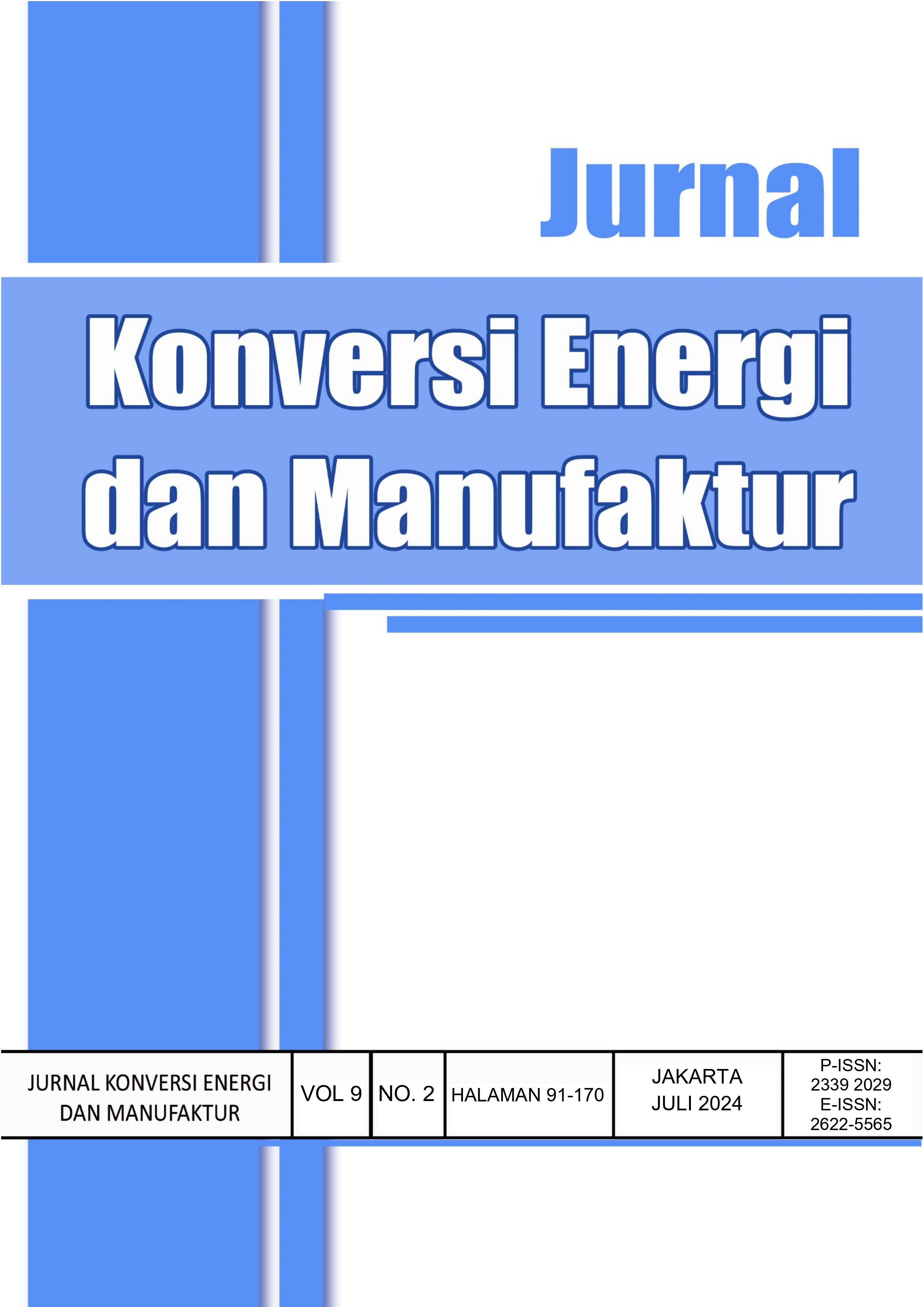PEMBUATAN PADUAN INTERMETALIK Mg2Si DENGAN DOPING BISMUTH SEBAGAI MATERIAL TERMOELEKTRIK
Synthesis of Bismuth Doped Mg2Si Intermetallic Alloy as a Thermoelectric Material
DOI:
https://doi.org/10.21009/JKEM.9.2.6Keywords:
Waste Heat, Efficiency, Thermoelectric Material, Mg2Si, Lattice ConstantAbstract
Increasing efficiency in gasoline fuel consumption in motorized vehicles is currently continuing. One way this is done is by making use of the energy that is lost during the combustion of a motorcycle engine. About half of the energy produced during burning will be lost due to heat energy and exhaust gases. This waste heat can be utilized by converting it into another form of energy. Thermoelectric materials are those that can convert heat energy into electricity directly. Thus, in this work, we synthesized the bismuth-doped Mg2Si thermoelectric material using a solid-state reaction method using a powder in a sealed tube technique. The initial step in the production process involves measuring the raw materials bismuth, silicon, and magnesium using the Mg2Si1-xBix formula (x = 0.00, 0.025, and 0.045). The raw material powder is grinded in a shaker mill before being sealed in a stainless steel tube. The powder is sealed in a tube and heated to 800 °C for 6 hours. According to XRD test results, the Mg2Si phase and Si and MgO phases have formed. The lattice constant of the cubic Mg2Si phase was found at ~0.636 nm. A SEM investigations of surface morphology suggest that bi-doping on Si sites influences grain size refinement. Therefore, it can be concluded that the Mg2Si intermetallic alloy production process was successfully completed.
References
[2] C. Nakhowong, T. Sumpao, and T. Seetawan, “Synthesis and Characterization of Mg2Si Thermoelectric Material,” Adv. Mater. Res., vol. 802, pp. 213–217, 2013, doi: 10.4028/www.scientific.net/AMR.802.213.
[3] S. A. Chandra, R. Roberto, D. P. Utama, D. Zulkarnain, D. S. P. Bratawan, M. S. Suherman, A. Gayatri, A. Tjahjono, M. Y. Hasbi, and S. D. Yudanto, “Mg2Si Intermetallic Alloys : Phase Growth and Microstructure,” Acta Metall. Slovaca, vol. 29, no. 2, pp. 108–112, 2023, doi: 10.36547/ams.29.2.1840.
[4] J. I. Tani and H. Kido, “Thermoelectric Properties of Bi-doped Mg2Si Semiconductors,” Phys. B Condens. Matter, vol. 364, pp. 218–224, 2005, doi: 10.1016/j.physb.2005.04.017.
[5] S. Choi, K. Kim, I. Kim, S. Kim, and W. Seo, “Thermoelectric Properties of the Bi-doped Mg2Si System,” Curr. Appl. Phys. J., vol. 11, pp. 388–391, 2011, doi: 10.1016/j.cap.2011.01.031.
[6] M. Ioannou, G. S. Polymeris, E. Hatzikraniotis, K. M. Paraskevopoulos, and T. Kyratsi, “Effect of Bi-doping and Mg-excess on The Thermoelectric Properties of Mg2Si Materials,” J. Phys. Chem. Solids, vol. 75, pp. 984–991, 2014, doi: 10.1016/j.jpcs.2014.04.008.
[7] J. Li, X. Li, C. Chen, W. Hu, F. Yu, Z. Zhao, L. Zhang, D. Yu, Y. Tian, and B. Xu, “Enhanced Thermoelectric Performance of Bismuth-Doped Magnesium Silicide Synthesized under High Pressure,” J. Mater. Sci., vol. 53, pp. 9091–9098, 2018, doi: 10.1007/s10853-018-2185-8.
[8] S. D. Yudanto, L. A. R. Hakim, M. E. H. Rasyadi, A. Imaduddin, and A. W. Pramono, “Sintesis dan Karakterisasi MgB2 dengan Penambahan Nano-SiC melalui Metode Reaksi Padat,” Indones. J. Appl. Phys., vol. 12, no. 1, pp. 108–115, 2022, doi: 10.13057/ijap.v12i1.49136.
[9] S. D. Yudanto, Y. P. Dewi, P. Sebayang, S. A. Chandra, A. Imaduddin, B. K., and A. Manaf, “Influence of CNTs Addition on Structural and Superconducting Properties of Mechanically Alloyed MgB2,” J. Met. Mater. Miner., vol. 30, no. 3, pp. 9–14, 2020, doi: 10.14456/jmmm.2020.32.
[10] A. C. Larson and R. B. V. Dreele, “General Structure Analysis System (GSAS),” vol. 748. 2004.
[11] H. Okamoto, “Mg-Si (Magnesium-Silicon),” J. Phase Equilibria Diffus., vol. 28, pp. 229–230, 2007, doi: 10.1007/s11669-007-9038-5.
[12] D. Stathokostopoulos et al., “Synthesis and Characterization of Nanostructured Mg2Si by Pack Cementation Process,” Results Mater., vol. 13, p. 100252, 2022, doi: 10.1016/j.rinma.2021.100252.
[13] S. Fiameni, S. Boldrini, S. Battiston, F. Agresti, A. Famengo, and S. Barison, “Synthesis and Characterization of Bi-doped Mg2Si Thermoelectric Materials,” in AIP Conference Proceedings, 2012, pp. 191–194. doi: 10.1063/1.4731529.






















